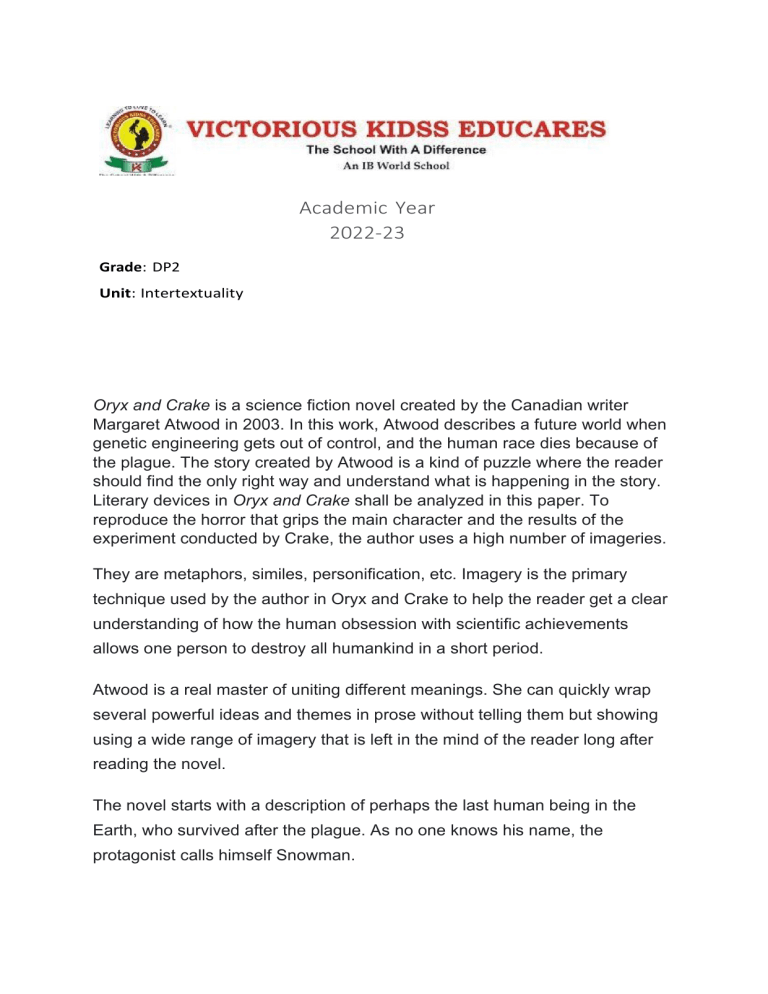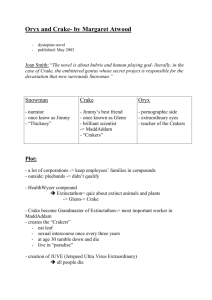
Academic Year 2022-23 Grade: DP2 Unit: Intertextuality Oryx and Crake is a science fiction novel created by the Canadian writer Margaret Atwood in 2003. In this work, Atwood describes a future world when genetic engineering gets out of control, and the human race dies because of the plague. The story created by Atwood is a kind of puzzle where the reader should find the only right way and understand what is happening in the story. Literary devices in Oryx and Crake shall be analyzed in this paper. To reproduce the horror that grips the main character and the results of the experiment conducted by Crake, the author uses a high number of imageries. They are metaphors, similes, personification, etc. Imagery is the primary technique used by the author in Oryx and Crake to help the reader get a clear understanding of how the human obsession with scientific achievements allows one person to destroy all humankind in a short period. Atwood is a real master of uniting different meanings. She can quickly wrap several powerful ideas and themes in prose without telling them but showing using a wide range of imagery that is left in the mind of the reader long after reading the novel. The novel starts with a description of perhaps the last human being in the Earth, who survived after the plague. As no one knows his name, the protagonist calls himself Snowman. “Snowman wakes before dawn. He lies unmoving, listening to the tide coming in wave after wave sloshing over the various barricades, wish-wash, the rhythm of heartbeat. He would so like to believe he is still asleep.” (Atwood 1) Oryx and Crake essay evidences that Employing flashbacks, Snowman remembers what has happened earlier and brought to the world fell apart. In his past life, he was Jimmy. He had a best friend, Glenn, a smart student who wanted to change the world for better. With time, Glenn changes his name into Crake. The world, Jimmy and Glenn live in, is not perfect and has its pros and cons. People live and work in communities called Compounds. These communities provide safety for society. However, life in such Compounds is predictable and controlled by a specific security system (CorpsSeCorps). Jimmy’s father finds such a community to be the best option to live in: “Long ago, in the days of knights and dragons, the kings and dukes had lived in castles, with high walls and drawbridges and slots on the ramparts so you could pour hot pitch on your enemies, said Jimmy’s father, and the Compounds were the same idea. Castles were for keeping you and your buddies nice and safe inside, and for keeping everybody else outside.” (Atwood 26). Jimmy’s father refers to this very community – safe and sound. He proves his son that they are those dukes and kings that live perfect lives without any troubles. Unfortunately, these Compounds are not idle, as it may seem at a glance. The father forgets about his son’s birthday all the time and does not involve in his son’s life. Atwood uses this type of metaphor, calling the society “Compounds” to emphasize the herd instinct inherent to that “idle world,” the inability to make choices, and follow their own desires. According to Oryx and Crake character analysis, Oryx and Crake are the two quite mysterious characters. Oryx is a serenely and calm person. She realizes that it is impossible to change the situation, and it will be better to accept everything as it is. Even though she was a sex-slave sold by her parents, she tries to pay attention only to the positive aspects of her life. She gets the role to be the mother of our future, the mother of Crakers. In contrast to Oryx’s naivety, Crake seems to be rather an ambitious person who pursues the same goal – to change the world for the better, taking into consideration his preferences. The actions taken by Crake seem perfect to him. He notices every wrong detail in the existent society and thinks over the ways to change it. Playing violent video games and watching intense programs make Crake disrespect his own life and the society he lives in. This character may be considered as an example of a negative personification of progress. He wants to achieve his aim and reform a perfect society that will be in harmony with nature and each other so that he creates his first creatures, the Crakers. At the same time, Crake’s inventions cause a pandemic that kills all humans on the Earth. Only Jimmy remains alive because of being vaccinated to become a supervisor for the Crakers: “Although the Crakers weren’t his business they were now his responsibility Who else did they have?” (Atwood 348) The imagery of Crakers is used to describe some novelty that humankind has never met before. It is not accidental that the word “Crakers” is the analogy of the two words “create” and “crackle” – create something unusual, wild, and even dangerous for humans, something that with time can be crashed down. There is one more example of this literary technique in the novel that needs to be analyzed – the imagery of cats. It is known that cats are the only domestic animals, which retain their natural behavior in any situation and always follow their instincts, even more than dogs. This is why cats are nuisance animals in the perfect world created by Crake, the worlds of Crakers: “They were supposed to eliminate feral cats, thus improving the almost non existent songbird population. The bobkittens wouldn’t bother much about birds…” (Atwood 348) The main character, Snowman, has something in common with cats. He cannot but accept all the changes in the world, however, he tries not to forget about personal preferences and desires. He does not want to be a victim of circumstances as Crake and Oryx are. The only possible way out that Snowman sees is death. However, Atwood does not reveal what happens to Snowman. This is what the reader may think about and evolve their ideas. Oryx and Crake literary analysis shows that the use of imagery in the novel Oryx and Crake is mighty indeed. The images of the main characters and society they live in help Atwood create an atmosphere of the future, the future that was created through scientific achievements and human obsession. Margaret Atwood introduces a brilliant idea that all humankind may be easily destroyed by its lust and arrogance. This story is not about hope and happiness. This is a story about the obsession of living in a perfect world and the power to change other lives. Literary devices in Oryx and Crake such as imagery techniques that are chosen by the writer help the reader to comprehend the horror of personal desires and powers to make these desires come true. Works Cited Atwood, Margaret. Oryx and Crake. New York: Nan A. Talese, 2003. https://ivypanda.com/essays/oryx-and-crake-imagery-in-thenovel/#:~:text=They%20are%20metaphors%2C%20similes%2C%20personification,humankind%20in %20a%20short%20period. Two of her most recent novels, Oryx and Crake, published in 2003, and The Year of the Flood, which came out in 2009, depict in the realm of speculative fiction the blurred boundaries in relation to the roles mentioned above and portray protagonists that rely on telling their own story as a survival technique. The theme of writing and the act of storytelling and their relation to survival are recurrent themes in Atwood’s work. Both Oryx and Crake and The Year of the Flood present a postapocalyptic world in which most humans have died because of an act of bioterrorism: a deadly virus caused the death of billions. The ones who survived inherited a wasteland, since life on the planet become hostile to humans. Genetically modified animals have gone wild and there is no food in a planet climatically changed because of global warming. The only creatures apparently able to survive under these circumstances are the Crakers, a gene spliced species created from an experiment derived from human beings, who are able to eat grass and live comfortably in the hot weather. The question posed is whether the Crakers can be considered humans or not, since they are apparently unable to produce any form of art or symbolic thinking and express themselves in a very simple language. Oryx and Crake presents two narrative layers: one that happens before the near extinction of humans and other that happens after it. The first layer reveals a third-person narrator whose focus is Snowman, a Last Man character in the tradition of narratives that 4 depict the last male human alive, such as the novels Last Man, by Mary Shelley, and I Am Legend, by Richard Matheson. Apparently the only one to survive the world pandemics, Snowman has to cope with the idea of being the repository of human culture. He then starts telling his own story to himself. By doing this, a new layer of narrative is introduced. Snowman tells the story of Jimmy, as he was known before the catastrophe. The novel subsequently goes back and forth, presenting the perspectives of Snowman and Jimmy, and the reader is forced to establish connections between the two narratives as well as to acknowledge the artificiality of Snowman’s attempt to split himself into two different personas: Snowman, now in the present, and Jimmy, his past self. Snowman lives a nightmare in a wilderness scenario. The world he finds himself in is hostile: there is no food, global warming has changed the climate, and gene-spliced dangerous animals now gone wild constitute a threat. Moreover, the lack of human contact is making him lose his mind. He assumes the responsibility of taking care of the Crakers, the genespliced creatures derived of human DNA, but the lack of humanity in them – or so it seems to him – contributes to his escalating insanity. In an attempt to understand what happened to the world and to explain it to the Crakers, Snowman creates a mythology for them in which Oryx – a mysterious Asian woman who was his lover in the past – and Crake – his best friend, the scientist responsible for the plague that erased human life from the planet – are divine figures and he, Snowman, is their prophet. His mythmaking and the stories he creates to himself consist his survival strategy: it is his only way to cope with the extermination of humanity. Like Jimmy, this protagonist lives in a sort of nightmare. He faces a consumerist society that naturalizes violence and favours science over any artistic expression. A satirical version of our highly capitalist society, this second layer of the novel is also bleak and Jimmy finds no place in it either. He is a “words person,” someone with abilities in language in opposition to a “numbers person,” a person good at mathematics and physics, in a world that only values scientific knowledge. With an unusual inclination towards old forms of art that are now completely out of date in a society that believes solely in science as a form of knowledge, Jimmy remains marginalized, even though he belongs to the rich elite. Throughout the novel, he is the only character to question the way violence and pornography affect people and to realize the important role of art for humans. Because of these abilities, he is constantly depressed and finds in language a relief from the emptiness of his daily life by inventing new words and trying to save old ones from oblivion. But despite his dissatisfaction with the current social order, Jimmy, portrayed as an ambivalent character, does nothing to change it.






